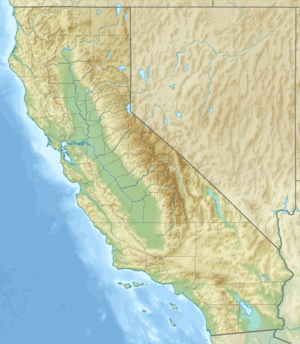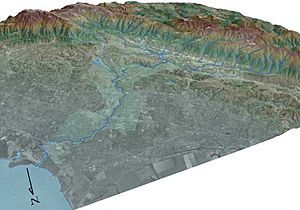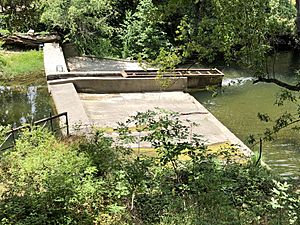San Francisquito Creek facts for kids
Quick facts for kids San Francisquito Creek |
|
|---|---|
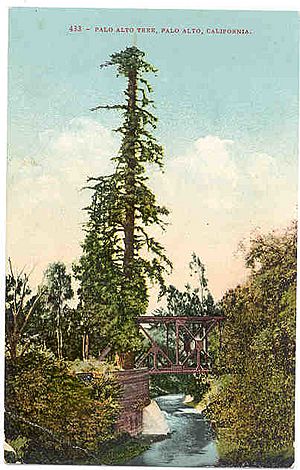
El Palo Alto and the San Francisquito Creek
c. 1910 |
|
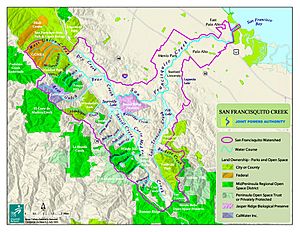
San Francisquito Creek watershed with named tributaries
|
|
|
Location of the mouth of San Francisquito Creek in California
|
|
| Native name | Arroyo de San Francisquito |
| Country | United States |
| State | California |
| Region | Northwestern Santa Clara County and southeastern San Mateo County |
| City | Palo Alto, California |
| Physical characteristics | |
| Main source | Confluence of Bear Creek and Corte Madera Creek just below Searsville Lake (actually a reservoir) Jasper Ridge Biological Preserve 351 ft (107 m) 37°24′26″N 122°14′15″W / 37.40722°N 122.23750°W |
| River mouth | Southwest San Francisco Bay East Palo Alto, California 0 ft (0 m) 37°27′58″N 122°06′55″W / 37.46611°N 122.11528°W |
| Basin features | |
| Tributaries |
|
San Francisquito Creek is a stream in California that flows into the southwest part of San Francisco Bay. Its name comes from Spanish, meaning "Little San Francisco." Long ago, in 1776, Juan Bautista de Anza called it the Arroyo de San Francisco. This creek flows through several towns and cities like Portola Valley, Woodside, Menlo Park, Palo Alto, and East Palo Alto. The creek and its branch, Los Trancos Creek, form the border between San Mateo and Santa Clara counties.
Contents
History of San Francisquito Creek
Early Inhabitants and Explorers
The first people to live in this area were the Ohlone people. The Spanish called them "Coastanoans" because they lived near the coast. These people gathered nuts, berries, and fish from the ocean and the bay. They had plenty of food, so they did not need to farm. We still find signs of their ancient villages along San Francisquito Creek today.
In 1769, a Spanish exploration group led by Don Gaspar de Portolà camped by the creek. They stayed there for five nights after they discovered San Francisco Bay. A missionary named Juan Crespí, who was with the group, wrote in his diary about their stay. The leaders decided to turn back to Monterey Bay, which was their original goal.
In 1774, Father Francisco Palóu placed a cross near a giant redwood tree by the creek. This tree is now called "El Palo Alto". He wanted to mark the spot for a new mission, but the mission was later built elsewhere as Mission Santa Clara de Asís. In 1776, Juan Bautista de Anza led another expedition. He found Father Palou's cross. However, the creek did not have enough water in summer to support a mission.
Understanding the Creek's Watershed
Where the Creek Begins
The San Francisquito watershed starts in the Santa Cruz Mountains. This area is about 667 meters (2,188 feet) above the Bay. Many smaller creeks flow into San Francisquito Creek from these mountains.
The main part of the creek starts where Bear Creek and Corte Madera Creek meet. This spot is just below Searsville Lake, which is actually a reservoir. The lake is inside the Jasper Ridge Biological Preserve. Stanford University bought this land in 1892.
Searsville Dam was built in 1892. It is 65 feet (20 meters) tall and 275 feet (84 meters) wide. The dam looks like a giant staircase made of concrete. Stanford University closed the lake to the public in 1975. Over time, the lake has filled with a lot of mud and dirt. This means it holds much less water now. Searsville Dam does not provide drinking water, help with floods, or make electricity.
How the Creek Flows
San Francisquito Creek flows for about 12.5 miles (20 kilometers). After leaving the hills, it flows through a wide, flat area. Finally, it empties into the Bay. The area that drains into the creek, called its watershed, is about 110 square kilometers (42 square miles). This area covers parts of San Mateo and Santa Clara counties.
For some of its path, the creek forms the border between Palo Alto and East Palo Alto or Menlo Park. This also makes it the border between San Mateo and Santa Clara counties. This is because it was once the boundary between the lands of the Spanish missions in San Francisco and Santa Clara. The famous tree, El Palo Alto, which gave Palo Alto its name, stands by the creek.
In 1857, there were about 1,142 acres (462 hectares) of tidal marsh at the creek's mouth. These are wetlands that are flooded by tides. There were also large areas of willow trees. By 2004, much of this marshland had been filled in. Areas like the Palo Alto golf course and the Palo Alto Airport were built on these filled lands.
Wildlife and Nature in the Creek
Fish Life: Steelhead Trout and Salmon
San Francisquito Creek is home to a special type of fish called steelhead trout. These fish are anadromous, meaning they live in the ocean but return to freshwater to lay their eggs. This creek has one of the healthiest steelhead populations in the southern San Francisco Bay. The creek has stayed very natural because the counties on either side could not agree on paving it over.
Scientists have found evidence that coho salmon also lived in San Francisquito Creek long ago. Old stories from people who lived nearby say that coho salmon were common in the creek in the early 1900s. One person remembered catching salmon near Searsville Dam when it overflowed in winter. Another person recalled catching "steelhead" and silver (coho) salmon in the 1930s and 1940s.
Dams and Fish Passage
In the past, several dams built by Stanford University made it hard for fish to swim upstream. These dams blocked the path for trout and salmon trying to lay their eggs. One dam, the Lagunita Diversion Dam, was on the main part of San Francisquito Creek. It blocked fish from reaching many smaller creeks. Another dam, the Jasper Ridge Road Crossing, also made it difficult for fish to pass.
In recent years, Stanford has removed two of these barriers. The Lagunita Diversion Dam was taken out in 2018. This helped fish move freely again. The Jasper Ridge Road Crossing was replaced with a bridge. This opened up more miles of creek for fish to swim and lay eggs.
The Searsville Dam is still a major barrier for fish. It blocks the largest branch of the creek, Corte Madera Creek. If this dam were removed, it could open up 10 miles (16 km) of new habitat for steelhead trout. Stanford University is looking into ways to make Searsville Dam less of a barrier for fish. They are thinking about making a hole through the dam or rerouting the creek around it.
Other Animals and Plants
The creek is also home to other important animals. These include the California red-legged frog and the western pond turtle. Both of these species are threatened.
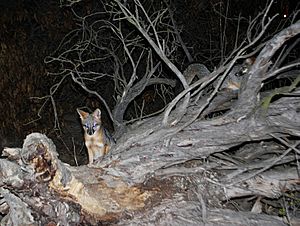
Recently, gray foxes have been seen near the creek's mouth and on the Palo Alto Golf Course. Their numbers have grown because harmful red foxes, which prey on endangered birds, have been controlled. Gray foxes are unique because they are the only type of dog family animal that can climb trees.
The upper parts of the watershed have forests of oak and madrone trees. There are also open grasslands. A special group of coast redwood trees grows along the creek below Searsville Lake. Other native trees along the creek include valley oak, coast live oak, and willows. Common shrubs are coffeeberry and ocean spray.
Protecting the Creek
Normally, the creek flows slowly in a deep channel. In summer, it often dries up. However, it can flood during heavy rains. This risk has grown because more buildings and paved areas mean less water soaks into the ground. In 1998, during a strong El Niño storm, the creek overflowed its banks.
The Santa Clara Valley Water District helps manage and protect the creeks in this area. Because San Francisquito Creek is so important, a special group called the Joint Powers Authority (JPA) was formed. This group works to address community concerns about the creek. They are planning projects to improve the creek, like strengthening its banks and planting more native plants. The JPA includes leaders from Palo Alto, Menlo Park, East Palo Alto, the Santa Clara Valley Water District, and the San Mateo County Flood Control District.


